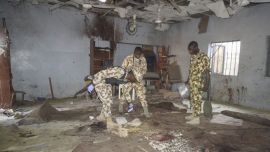Responding to financial instability and a wild swing in parallel exchange rates, Argentina’s Economy Minister Sergio Massa vowed Tuesday to use “all the tools of the state” to bring “order” to currency markets.
The minister lashed out at “rumours and false reports” in a series of posts on social media, which he blamed for turbulence in foreign exchange markets. The Central Bank intervened strongly to prop up the official rate, selling AL30 bonds to contain the unrest.
"For several days we have been living an atypical situation of rumours, versions, false reports and their consequent impact on the financial instruments linked to the dollar," Massa said in the beginning of a thread on Twitter.
"We are going to use all the tools of the State to put this situation in order and in this sense we notified the IMF of the restrictions that weigh on Argentina and that we are going to change in the rediscussion of the programme," added the minister.
Massa said the government had informed the International Monetary Fund that it would need to renegotiate parts of its US$44.5-billion debt programme as part of a move to stabilise the economy.
The remarks came as the so-called ‘dólar blue’ illegal and parallel rate soared close to 500 pesos per greenback in midday trading, prompting the Central Bank to intervene and prop up the official rate at 227. The ‘blue’ later calmed, settling at a record high of 482 by late afternoon, leaving the “brecha” or gap between the official and unofficial rate at more than 123 percent.
The CCL ('contado con liquidación') dollar, another parallel exchange rate derived from buying securities locally and selling them abroad, rose to 472 pesos to the dollar, also a record high. The MEP (‘mercado electrónico de pagos’) rate, a legal form of obtaining foreign currency via the purchase and sale of bonds quoted in pesos, weakened to 462.
Argentina’s economy is projected to grow just 0.2 percent, according to IMF estimates, though private economists in Buenos Aires are projecting a contraction of between two and four percent, in large part due to a record drought that is expected to slash foreign currency inflows.
Inflation accelerated to 7.7 percent in March, with analysts projecting a steeper rate to come for April. From a year ago, prices have risen 104.3 percent, the highest annual level since 1991, according to government data.
Uncertainty continues to grip economic actors with no clear definitions from the government over how Argentina will obtain the dollars needed to sustain imports.
Blame game
In his tweets, Massa also announced that the Comisión Nacional de Valores (CNV) securities regulator and the Unidad de Información Financiera (UIF) money-laundering watchdog would be tasked with “investigating and clarifying” suspicious trading, alluding to unfair pressures on the exchange market.
"At the same time, we are going to continue with the multilateral agreements, exporters with the transformation of exports into yuan and the disbursement agreement with the IMF to strengthen the reserves that were damaged by the impact of the drought," concluded Massa in his statements.
Hours before Massa took to social media, President Alberto Fernández had criticised the "permanent practice of the Argentine right wing, of spreading rumours in the morning and withdrawing their returns from the exchange market when the day ends."
Eugenio Marí, chief economist of the Fundación Libertad y Progreso, said the financial instability indicated that "uncertainty is at the highest level of the entire Alberto Fernández administration."
The economist explained that we see "a demand for pesos that continues to fall faster and faster – it has already reached its lowest level in 20 years, which is directly reflected in the price of parallel exchange rates and in the growth of the exchange rate gap.”
– TIMES/NA/PERFIL























Comments